| Term |
Source |
Meaning |
Illustration |
| Sabre-toothed Tiger |
439 Combat support Sqn,,RCAF. Vol VI, P 128 |
 The Sabre-toothed Tiger is a prehistoric animal related to the modern tiger. It is used here to depict the nickname of the squadron which flew the Sabre jet. It may also be used to suggest ferocity. The Sabre-toothed Tiger is a prehistoric animal related to the modern tiger. It is used here to depict the nickname of the squadron which flew the Sabre jet. It may also be used to suggest ferocity. |
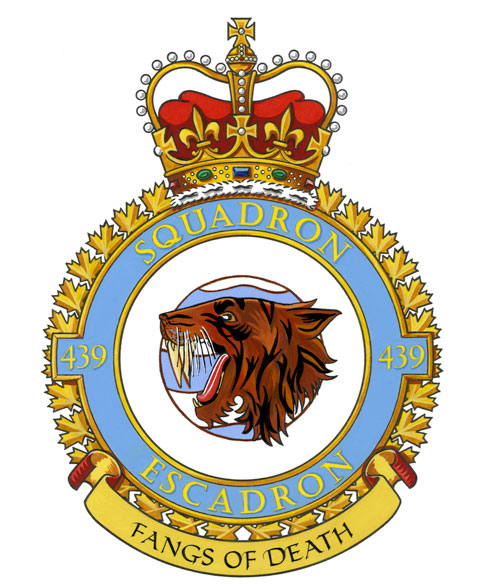 |
| Sailing Ship, Fully Rigged |
City of Quebec. Vol I, P 3 |
 The 17th-century Sailing Ship alludes to the arrival of Champlain and the original settlers in Quebec in 1608. The 17th-century Sailing Ship alludes to the arrival of Champlain and the original settlers in Quebec in 1608. |
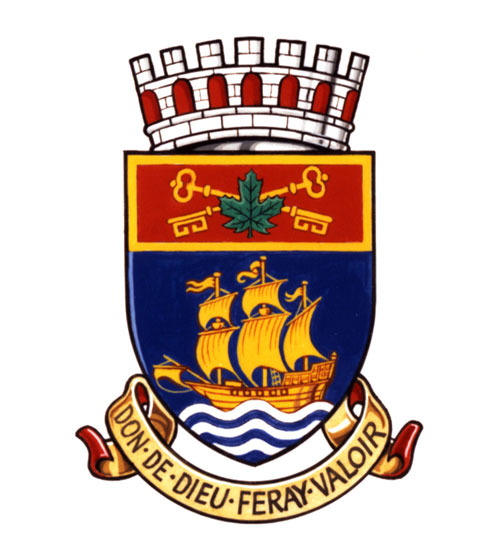 |
| Salmon (Coast Salish) |
Capilano University (Badge) Vol V, P 554 |
 The salmon is an important local species and is shown here in the artistic style of the Coast Salish nation. The salmon is an important local species and is shown here in the artistic style of the Coast Salish nation. |
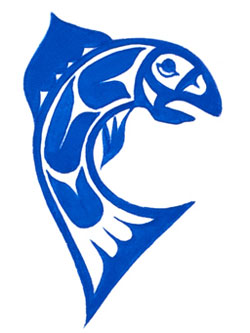 |
| Salt-bank Schooner |
Hagerman, B.A. Vol V, P 298 |
 The Salt-bank Schooner is typical of the sailing ships of Canada's East Coast. The Salt-bank Schooner is typical of the sailing ships of Canada's East Coast. |
 |
| Sand Dollar |
Jean, Michaëlle. Vol IV, P 1 |
 The Sand dollar is a marine creature found on both Atlantic and Pacific Coasts of Canada. It is a special talisman of Her Excellency. The Sand dollar is a marine creature found on both Atlantic and Pacific Coasts of Canada. It is a special talisman of Her Excellency. |
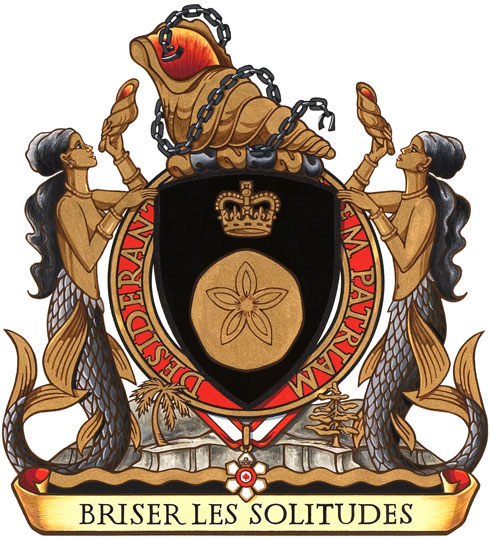 |
| Sapiné |
Greater Sudbury |
Sapiné refers to a division line formed of alternating fir trees. |
 |
| Sapinagé |
|
 Sapinagé refers to a division line formed of alternating fir twigs. Sapinagé refers to a division line formed of alternating fir twigs. |
 |
| Saskatoon Bush |
HJMCS Saskatoon. Vol III, P 382 |
 The Saskatoon Bush held in the lion’s paw is a direct reference to the name of the ship. The Saskatoon Bush held in the lion’s paw is a direct reference to the name of the ship. |
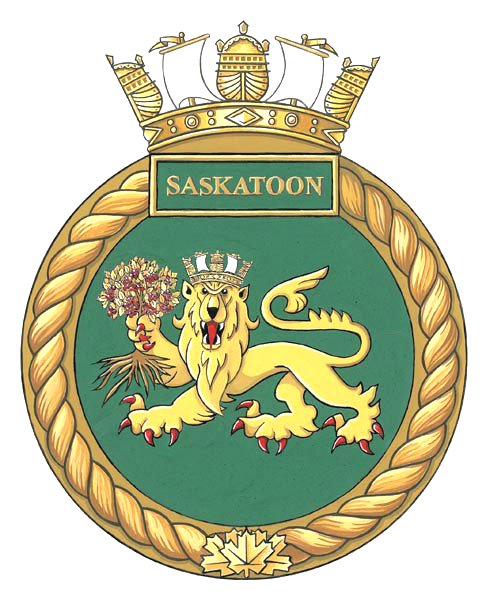 |
| Scimitar |
Reynolds, C.L. |
In Canadian practice, the distinction between the scimitar and the seax seems to have been abandoned, since the weapons illustrated are blazoned as scimitars, despite the notches in their backs. |
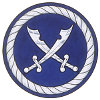 |
| Scottish Terrier |
Mikel, E.A. Vol IV, P 135 |
 The Scottish Terrier, or Scottie, is a popular companion. It is an independent and rugged breed, originating in Scotland. The Scottish Terrier, or Scottie, is a popular companion. It is an independent and rugged breed, originating in Scotland. |
 |
| Scuba Diver |
Munn, K A. Vol IV, P 79 |
 The Scuba Diver in these arms is a reference to the grantee’s experience as a diver. The Scuba Diver in these arms is a reference to the grantee’s experience as a diver. |
 |
| Sculptor's Mallet |
Jarvis, K.P. Vol II, P 390 |
 The Sculptor's wooden Mallet, as seen here in both shield and crest is the main implement of the sculptor and symbolic thereof. The Sculptor's wooden Mallet, as seen here in both shield and crest is the main implement of the sculptor and symbolic thereof. |
 |
| Sea Bison |
Lee, P. S-L. Vol V, P 539 |
 The Sea Bison is seen here as the dexter supporter. The bison is the Provincial animal of Manitoba. The lower body of a fish refers to the grantee's skills in limnology - the study of lakes and rivers. The Sea Bison is seen here as the dexter supporter. The bison is the Provincial animal of Manitoba. The lower body of a fish refers to the grantee's skills in limnology - the study of lakes and rivers. |
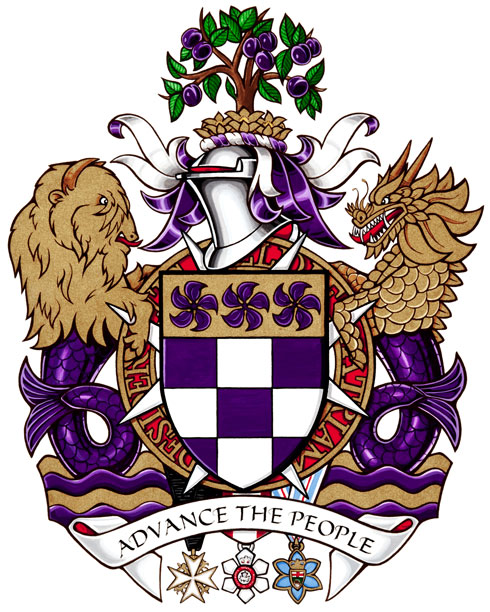 |
| Sea Boar |
Sweeney, L.K. Vol II, P 58 |
 The Sea Boar is an heraldic boar with a dolphin's tail. It suggests strength and power associated with the sea or maritime pursuits. The Sea Boar is an heraldic boar with a dolphin's tail. It suggests strength and power associated with the sea or maritime pursuits. |
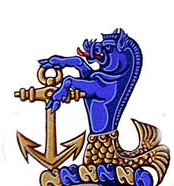 |
| Sea Caribou |
Royal St. John's Regatta Committee. Vol II, P 347 |
 The Sea Caribou combines the Body of a caribou with the tail of a fish. The Sea Caribou combines the Body of a caribou with the tail of a fish. |
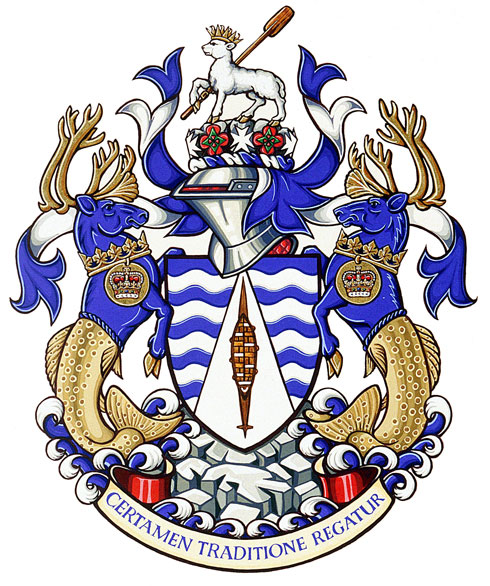 |
| Sea Cerberus |
5th Maritime Operations Group. Vol IV, P 163 |
 In Greek and Roman Mythologies, Cerberus is a three-headed dog guarding the Underworld. This creature has been converted into a sea monster to represent the maritime/naval nature of the Group. In Greek and Roman Mythologies, Cerberus is a three-headed dog guarding the Underworld. This creature has been converted into a sea monster to represent the maritime/naval nature of the Group. |
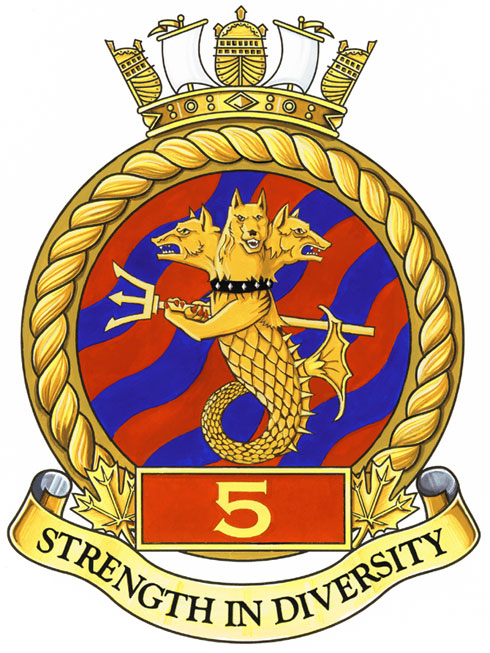 |
| Sea Cougar |
Finn, G. Vol II, P102 |
 The Sea Cougar, shown as the sinister supporter of the arms, combines the head and upper body of a cougar with the tail, scales and fins of a fish. The Sea Cougar, shown as the sinister supporter of the arms, combines the head and upper body of a cougar with the tail, scales and fins of a fish. |
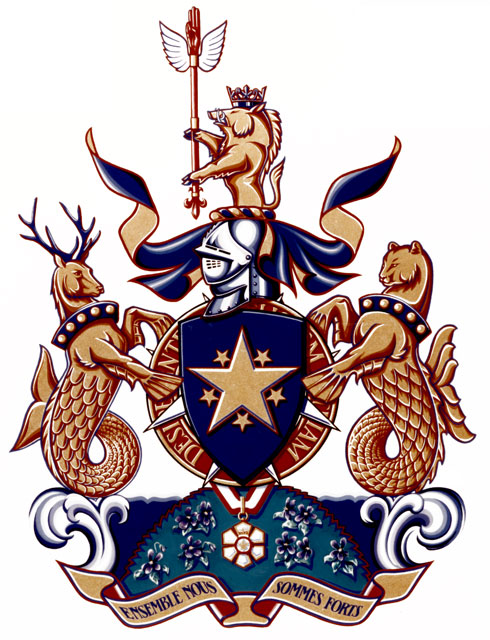 |
| Sea Deer |
Finn, G. Vol II, P102 |
 The Sea Deer shown as the dexter supporter of the arms, combines the head and upper body of a deer with the tail, scales and fins of a fish. The Sea Deer shown as the dexter supporter of the arms, combines the head and upper body of a deer with the tail, scales and fins of a fish. |
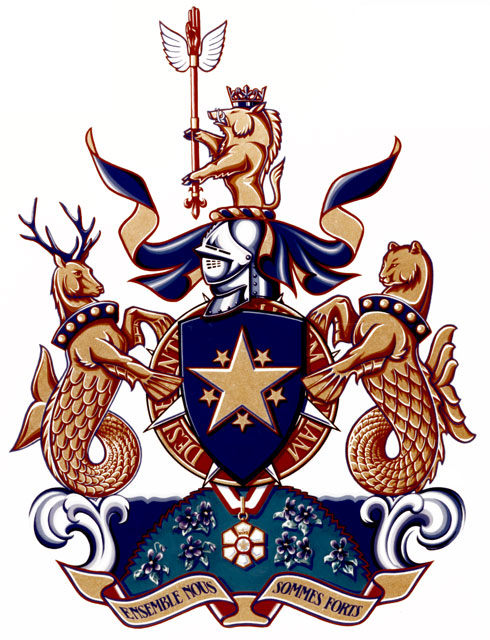 |
| Sea Doe |
Kwantlen Polytechnic University, Surrey, BC. Vol V, P 333 |
 The Sea Doe (the dexter supporter) is a combination of a female deer and a whale or porpoise, representing swiftness and tireless effort. The Sea Doe (the dexter supporter) is a combination of a female deer and a whale or porpoise, representing swiftness and tireless effort. |
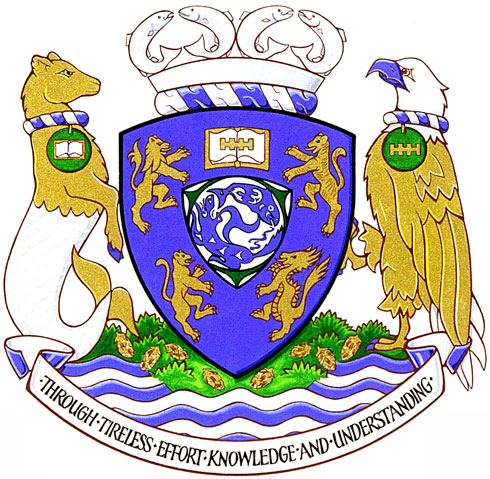 |
| Sea Griffin |
Canadian Mortgage Forces, Ltd. Vol VI, P242 |
 The Sea Griffin, combining the characteristics of an eagle, a lion and a fish, represents the three elements (air, land and sea) of the Canadian Forces. The Sea Griffin, combining the characteristics of an eagle, a lion and a fish, represents the three elements (air, land and sea) of the Canadian Forces. |
 |
| Sea Lion |
HMCS Windsor. Vol IV, P 17 |
 The Heraldic Sea Lion shows a lion with a fish's tail. It alludes to the lion supporters of the arms of the City of Windsor, Ontario, but with a fish's tail to suggest the sea. The Heraldic Sea Lion shows a lion with a fish's tail. It alludes to the lion supporters of the arms of the City of Windsor, Ontario, but with a fish's tail to suggest the sea. |
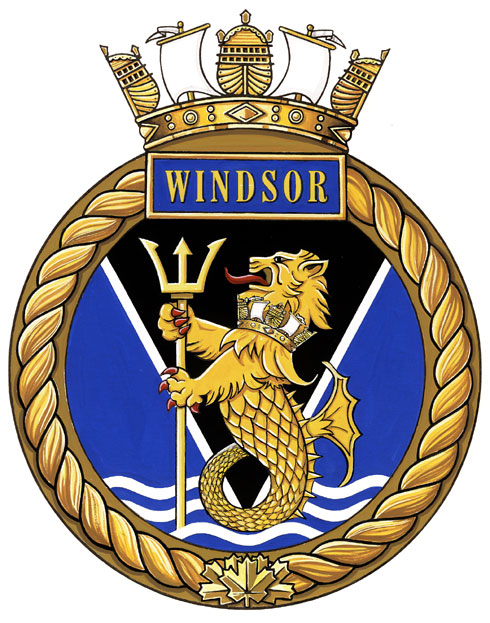 |
| Sea Otter |
Mitchell, G.A. Vol IV, P 417 |
 The Sea Otter is a reference to an important element of the 19th-century fur trade in north-western Canada. The Sea Otter is a reference to an important element of the 19th-century fur trade in north-western Canada. |
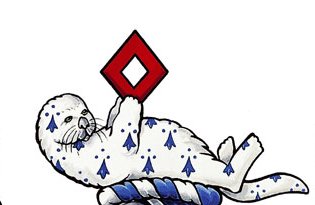 |
| Sea Owl |
Jones, C.H. Vol IV, P 502 |
 The Owl is an ancient symbol of wisdom. The lower, fish-like, part alludes to the grantee's love of water sports. The Owl is an ancient symbol of wisdom. The lower, fish-like, part alludes to the grantee's love of water sports. |
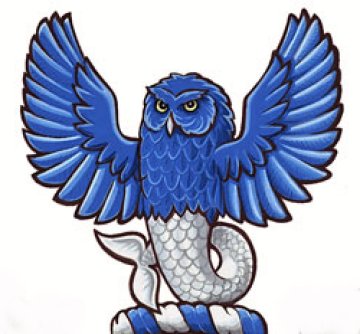 |
| Sea Qilin |
Lee, P. S-L. Vol, V, P 539 |
 The Sea Quilin is seen here as the sinister supporter. The Qilin is a hooved animal of Chinese mythology, representing benevolence, good will and good government. The lower body of a fish alludes to the Grantee's skills in limnology - the study of lakes and rivers. The Sea Quilin is seen here as the sinister supporter. The Qilin is a hooved animal of Chinese mythology, representing benevolence, good will and good government. The lower body of a fish alludes to the Grantee's skills in limnology - the study of lakes and rivers. |
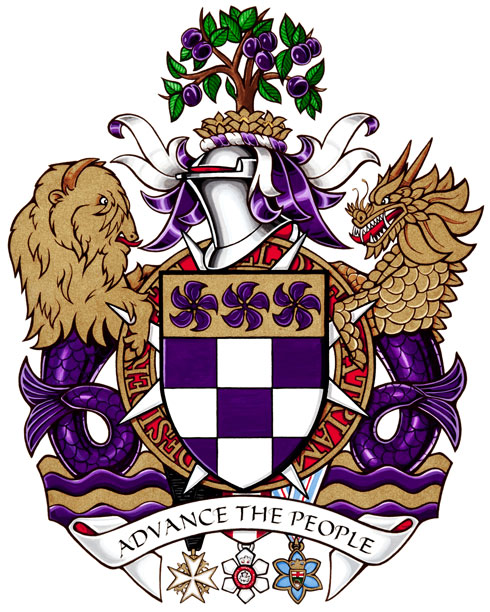 |
| Sea Scallop |
|
sea scallop differs from the standard heraldic escallop primarily in facing in the opposite direction with the "hinge" down. |
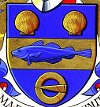 |
| Sea Stag |
Woods, A.T. Vol VI, P 245 |
 The Sea Stag (shown here on the dexter side of the shield) is a stag with a fish's tail. The Sea Stag (shown here on the dexter side of the shield) is a stag with a fish's tail. |
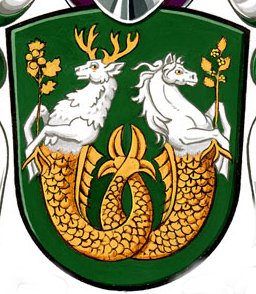 |
| Sea Tiger |
Royal Hamilton Yacht Club. Vol VI, P 23 |
 The Tiger alludes to the sinister supporter of the City of Hamilton's arms, while the fish's tail refers to the aquatic activities of the yacht club. The Tiger alludes to the sinister supporter of the City of Hamilton's arms, while the fish's tail refers to the aquatic activities of the yacht club. |
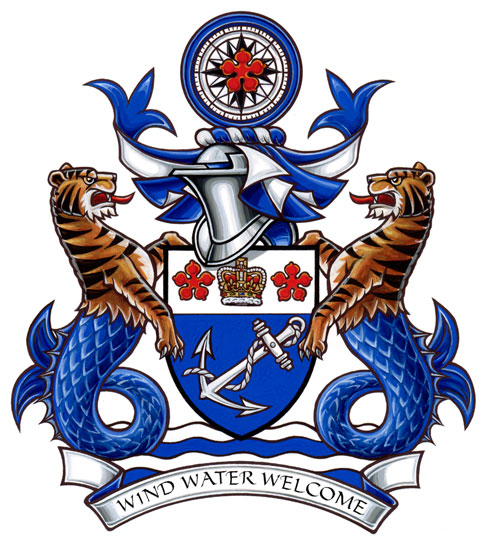 |
| Sea Turtle |
Chan, C.T. Vol VI, P 111 |
The Sea Turtle is a reference to the grantee's grandfather, who purchased sea creatures and released them back to the sea. It represents in this case care and generosity. It can also refer to travel by sea. |
 |
| Seahorse (Natural) |
Sajous, E. Vol V P 104 |
 The natural Sea Horse - as distinct from its well-known heraldic form - is a bony, scale-less fish that swims upright. It evokes the aquatic world. The natural Sea Horse - as distinct from its well-known heraldic form - is a bony, scale-less fish that swims upright. It evokes the aquatic world. |
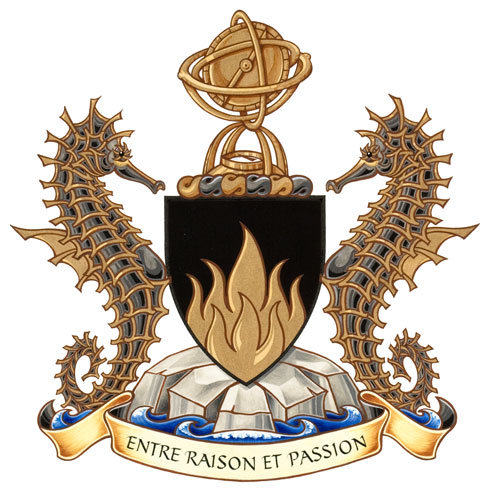 |
| Secretary Bird |
Roux, J-L. Vol IV, P 200 |
 The Secretary Bird is a predatory bird of Africa, used heraldically because of its name to refer to secretaries, journalists and authors. The Secretary Bird is a predatory bird of Africa, used heraldically because of its name to refer to secretaries, journalists and authors. |
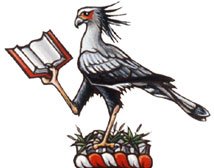 |
| Sedna |
Hanson, A.M. Vol V, P 146 |
 The dexter supporter in these arms (shown as a woman with a whale's tail) represents Sedna, a famous creature from mythology around the circum-polar world and known as the Sea Ruler of the Arctic. The dexter supporter in these arms (shown as a woman with a whale's tail) represents Sedna, a famous creature from mythology around the circum-polar world and known as the Sea Ruler of the Arctic. |
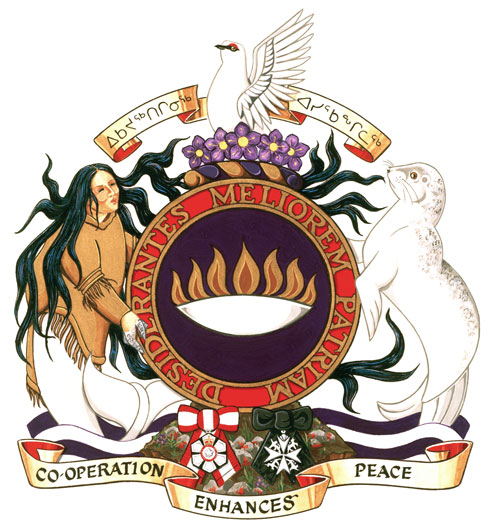 |
| Semaphore Flag |
Guité, M.J.C. (Badge) Vol V, P 113 |
The Semaphore Flags refer to the grantee’s career in the field of communications, but may also be used to allude to communications in general. |
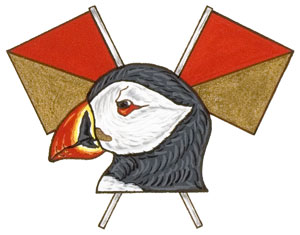 |
| Semaphore Tower |
Toccacelli, J.E. Vol VI, P 338 |
 The Semaphore Tower was a method of communicating messages over a visible distance, prior to the invention of the electric telegraph. The Semaphore Tower was a method of communicating messages over a visible distance, prior to the invention of the electric telegraph. |
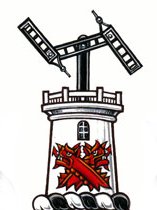 |
| Serpentine |
University Club of Montreal. Vol VI,P 116 |
 The curved partition line in bend sinister is blazoned as Serpentine. The curved partition line in bend sinister is blazoned as Serpentine. |
 |
| Sharp-shinned Hawk |
19 Wing, RCAF. (Badge) Vol III, P 372 |
 The Sharp-shinned Hawk is a small hawk of the US and Canada, occurring primarily in woodland country. The Sharp-shinned Hawk is a small hawk of the US and Canada, occurring primarily in woodland country. |
 |
| Shearwater |
12 Wing, RCAF (Badge) Vol III, P 367 |
 The Shearwater is pelagic bird of temperate and cool waters. These birds fly with stiff wings, using a shearing flight technique to skim across wave fronts with a minimum of active flight. The Shearwater is pelagic bird of temperate and cool waters. These birds fly with stiff wings, using a shearing flight technique to skim across wave fronts with a minimum of active flight. |
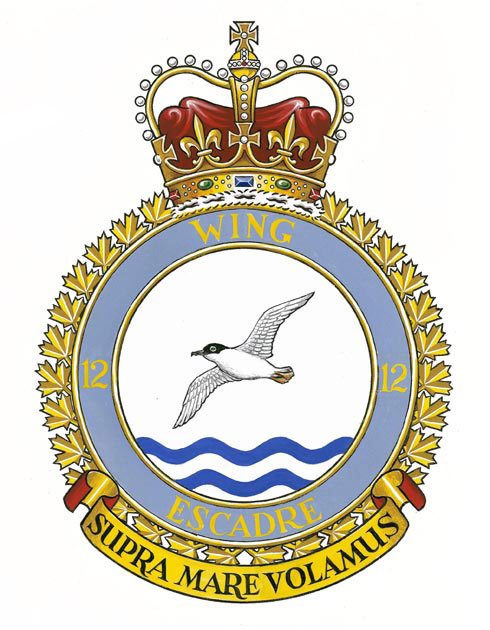 |
| Shield - East African |
Cardozo, V.A. Vol IV, P 132 |
 The shield shown here is typical of those used in Kenya, and refers to the grantee's place of birth. The shield shown here is typical of those used in Kenya, and refers to the grantee's place of birth. |
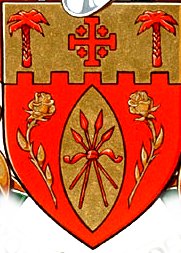 |
| Ship's Propeller |
Kinley, J.J. Vol III, P 189 |
 The Ship's Propeller, shown here in the base, alludes to the grantee's association with manufacturing for the fishing industry. The Ship's Propeller, shown here in the base, alludes to the grantee's association with manufacturing for the fishing industry. |
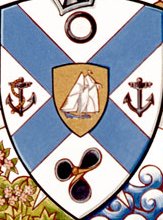 |
| Shofar |
Dowd, T.E. Vol VI, P 75 |
 The Shofar (shown here in base) is an ancient Jewish musical instrument, most often made from a ram’s horn. It is used in Bishop Dowd’s arms to symbolize the action of announcing the glory of God and the coming day of the Lord. The Shofar (shown here in base) is an ancient Jewish musical instrument, most often made from a ram’s horn. It is used in Bishop Dowd’s arms to symbolize the action of announcing the glory of God and the coming day of the Lord. |
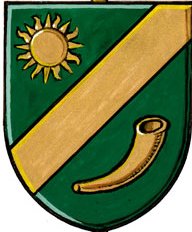 |
| Silo |
Gonyou, J.D. Vol V, P549 |
 The Silo (in its agricultural sense) is a cylindrical tower, often attached to a barn and used to store grain. It refers here to the family’s agricultural heritage. The Silo (in its agricultural sense) is a cylindrical tower, often attached to a barn and used to store grain. It refers here to the family’s agricultural heritage. |
 |
| Simbi |
Jean, Michelle. Vol IV, P 1 |
 Simbi (shown here as supporters) are water spirits from the Haitian culture, who comfort souls, purify troubled waters and intervene with wisdom and foresight. They allude to Her Excellency's Haitian background and the vital role of women in advancing social justice. Simbi (shown here as supporters) are water spirits from the Haitian culture, who comfort souls, purify troubled waters and intervene with wisdom and foresight. They allude to Her Excellency's Haitian background and the vital role of women in advancing social justice. |
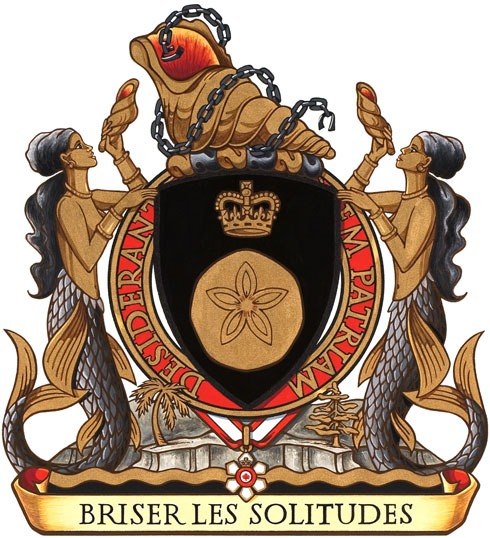 |
| Skis |
City of Rossland, BC. Vol III, P 145 |
 The Skis shown in the crest refer to the City of Rossland as a training centre for world-class skiers. The Skis shown in the crest refer to the City of Rossland as a training centre for world-class skiers. |
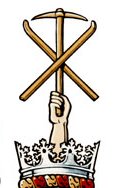 |
| Small-mouth Bass |
Town of Stewiacke, NS. Vol V, P 184 |
 The Small-mouth Bass shown held by the eagle in the crest symbolizes sport fishing in the local rivers. The Small-mouth Bass shown held by the eagle in the crest symbolizes sport fishing in the local rivers. |
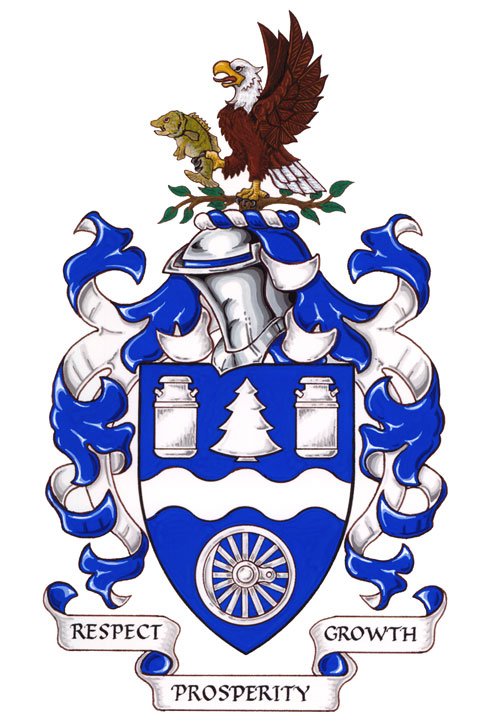 |
| Snow Goose |
714 Commun-ications Squadron (Badge) Vol II, P 401 |
 The Snow Goose is a North American species of goose, its name deriving from the typically white plumage. It nests and mates in arctic regions, but winters in warm parts of the continent, from western BC through parts of the US to Mexico. In these arms, it alludes to the wide range of communications performed by the Squadron. The Snow Goose is a North American species of goose, its name deriving from the typically white plumage. It nests and mates in arctic regions, but winters in warm parts of the continent, from western BC through parts of the US to Mexico. In these arms, it alludes to the wide range of communications performed by the Squadron. |
 |
| Snow Knife |
NCC Investment Group (Nunavut) Vol VI, First Nation, P1 |
 The Snow Knife (held by each of the supporters) is a tool used in the construction of igloos. The Snow Knife (held by each of the supporters) is a tool used in the construction of igloos. |
 |
| Snow Leopard |
Malaison, J.H.S. Vol VI, P 93 |
 The Snow Leopard is a large cat native to the mountain ranges of South Asia. It is the National Heritage Animal of Pakistan. It can recognize Pakistani origin or, as in this case, strength of character. The Snow Leopard is a large cat native to the mountain ranges of South Asia. It is the National Heritage Animal of Pakistan. It can recognize Pakistani origin or, as in this case, strength of character. |
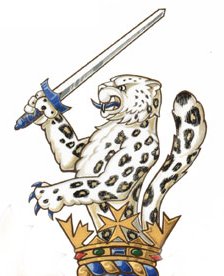 |
| Snowy Owl |
Gary R. Hayes |
The Snowy Owl is the provincial bird of Quebec. The Snowy Owl is a bird with exceptional vision and acute hearing and can detect prey at several miles distant. It is a bird of open country and unlike many owls is active during the daylight hours. |
 |
| Snowy Owl #2 |
771 Communi-cations Sqn. (Badge) Vol II, P 416 |
 The Snowy Owl is a large owl native to the arctic regions of North America and Eurasia. Many males are in fact, white, but females tend to be white with significant brown or black speckling. Unlike most other owls, the Snowy is not nocturnal, since during their breeding and nesting periods in the Arctic summer, there is almost constant daylight. The Snowy Owl is a large owl native to the arctic regions of North America and Eurasia. Many males are in fact, white, but females tend to be white with significant brown or black speckling. Unlike most other owls, the Snowy is not nocturnal, since during their breeding and nesting periods in the Arctic summer, there is almost constant daylight. |
 |
| Snowshoes |
Catholic Archdiocese of Edmonton. Vol V, P 479 |
 The Snowshoe, as seen in the sinister chief, is the classic North American form of winter-travel footwear. The Snowshoe, as seen in the sinister chief, is the classic North American form of winter-travel footwear. |
 |
| Sod House |
Schaaf |
The sod house of the early days of the Prairies has so far appeared in only a single grant, but it has potential for descendants of the early settlers in that area. |
 |
| Song Thrush |
Noyes Roberts, R.H. Vol III, P 321 |
 The Song Thrush is a European bird used here to suggest its beautiful song and the grantee's British origin. The Song Thrush is a European bird used here to suggest its beautiful song and the grantee's British origin. |
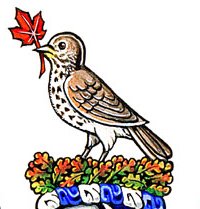 |
| Songbirds |
Orpheus Musical Theatre Society. Vol V, P 44 |
 Songbirds are a class of small birds noted for well-developed musical calls. They are used in this instance to refer to the musical elements of the Society’s productions. Songbirds are a class of small birds noted for well-developed musical calls. They are used in this instance to refer to the musical elements of the Society’s productions. |
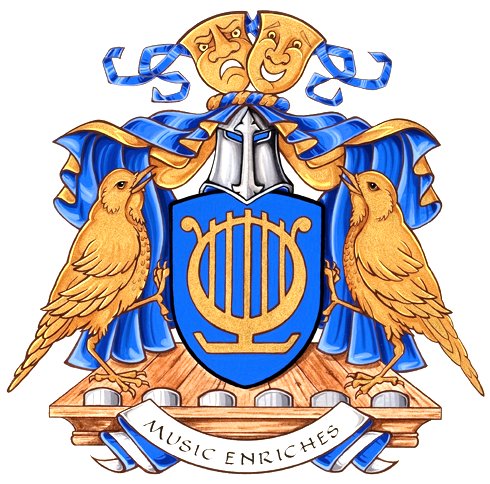 |
| Sparrowhawk |
Canadian Border Services Agency. Vol V, P 521 |
 The Sparrowhawk is a brave warrior with keen eyesight. The Sparrowhawk is a brave warrior with keen eyesight. |
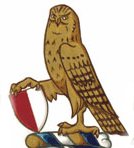 |
| Speaking Trumpet |
Brian T. Domander |
An ancient predecessor of the megaphone. |
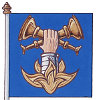 |
| Sperver |
Lawer |
Sperver is an obscure synonym for the better-known heraldic term pavilion. |
 |
| Spindle Whorl (Coast Salish) |
Emily Carr University. Vol V, P 332 |
 The blazon for this crest is - "Issuant from flames, a Coast Salish spindle whorl charged with a raven, all Argent, embellished Azure." The blazon for this crest is - "Issuant from flames, a Coast Salish spindle whorl charged with a raven, all Argent, embellished Azure." |
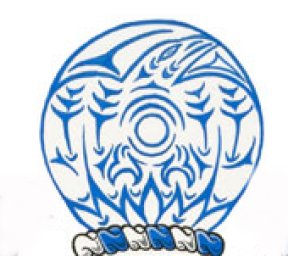 |
| Spirit of Kwantlen |
Kwantlen University College, Surrey, BC. (Badge). Vol III, P 314 |
 The Spirit of Kwantlen is a device of the Kwantlen First Nation, showing a wolf, a salmon and a river (the central swirl). It is used here as a symbol of the College. The Spirit of Kwantlen is a device of the Kwantlen First Nation, showing a wolf, a salmon and a river (the central swirl). It is used here as a symbol of the College. |
 |
| Sprocket |
Trials & Evaluations nit |
A sprocket is essentially a gear wheel voided. |
 |
| Spud Wrench |
Coates, F.R. Vol II, P 8 |
 The Spud Wrench (held here by the caribou) is a tool used by riggers in the construction of steel buildings. The Spud Wrench (held here by the caribou) is a tool used by riggers in the construction of steel buildings. |
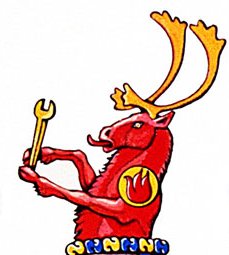 |
| St. Bartholomew's Knife |
Parish of St. Bartholomew, Ottawa, ON. Vol II, P 219 |
 St. Bartholomew, one of the Twelve Apostles, is traditionally pictured as holding a large knife in his hand, referring to the belief that he was martyred by being skinned alive. The knife pictured in these arms is similar to that held by a famous statue of the saint in the Basilica of St. John Lateran in Rome. St. Bartholomew, one of the Twelve Apostles, is traditionally pictured as holding a large knife in his hand, referring to the belief that he was martyred by being skinned alive. The knife pictured in these arms is similar to that held by a famous statue of the saint in the Basilica of St. John Lateran in Rome. |
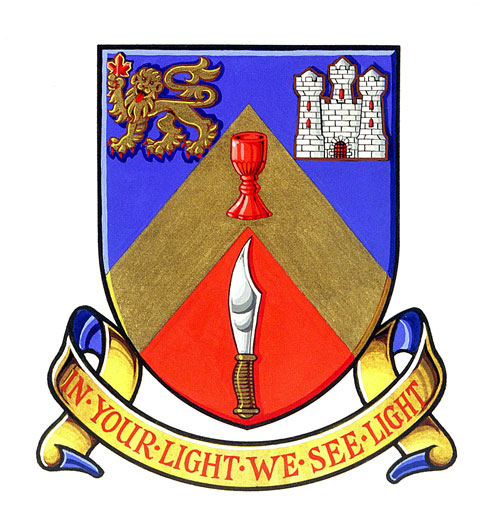 |
| St. Bernard Dog Playing a Piano |
Gignac, R. Vol V P 519 |
 The St. Bernard is well-known for loyalty, fidelity and obedience. The piano alludes to the grantee's love of music. The St. Bernard is well-known for loyalty, fidelity and obedience. The piano alludes to the grantee's love of music. |
 |
| Stage with Footlights |
Orpheus Musical Theatre Society. Vol V, P 44 |
 The Stage with footlights,– seen here as the compartment – alludes to the theatrical performances organized by the Society. The Stage with footlights,– seen here as the compartment – alludes to the theatrical performances organized by the Society. |
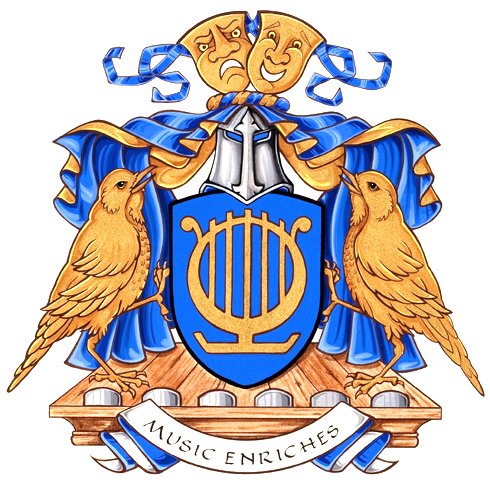 |
| Stagecoach |
Ville de Stanstead, Que. Vol. IV, P 117 |
The Stage Coach was a main form of overland transportation in early Canada. |
 |
| Star of Life |
Toronto Emergency Medical Services |
This useful innovation, consisting of three billets conjoined in asterisk (vide supra), the star so formed being charged with a rod of Aesculapeus, is known as the Star of Life. It is used as a symbol by many ambulance, para-medical and emergency services. |
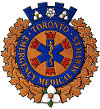 |
| Star of Life #2 |
Alberta Emergency Medical Services. (Badge) Vol, P548 |
 The Star of Life (shown in Azure) represents emergency medical services. The Star of Life (shown in Azure) represents emergency medical services. |
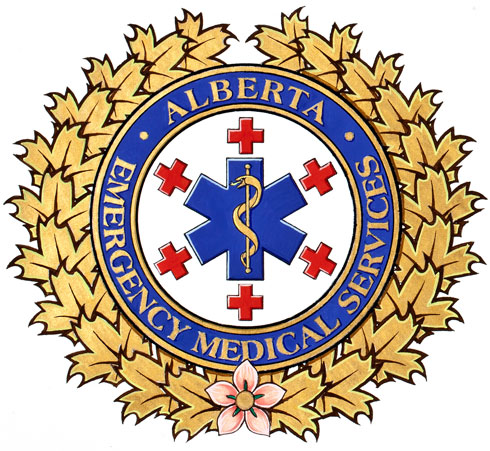 |
| Star of Vergina |
Roman |
 This delightful star (or sun) of sixteen separate points surrounding a central circle closely resembles a compass rose. Its name refers to the town of Vergina in northern Greece, where it was found during archeological ex-cavations. It is associated with Philip of Macedon, father of Alexander the Great. The fleur de lis is an added charge. This delightful star (or sun) of sixteen separate points surrounding a central circle closely resembles a compass rose. Its name refers to the town of Vergina in northern Greece, where it was found during archeological ex-cavations. It is associated with Philip of Macedon, father of Alexander the Great. The fleur de lis is an added charge. |
 |
| Starburst |
HMCS Preserver. Vol V, P 385 |
 The Life Preserver is a direct reference to the ship's name. The Starburst at its centre represents the flare that is automatically ignited when the flare touches the water. The Life Preserver is a direct reference to the ship's name. The Starburst at its centre represents the flare that is automatically ignited when the flare touches the water. |
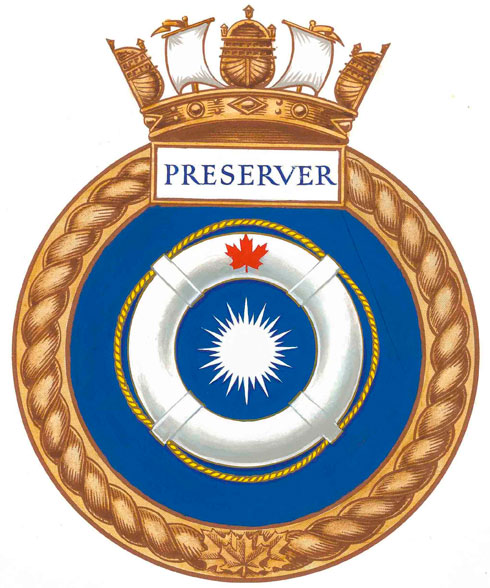 |
| Steam Locomotive Affronty |
City of North Battleford, Sask. Vol V, P 151 |
 The Locomotive is seen here in frontal view. It symbolizes the importance of the railroad in the development of Western Canada. The Locomotive is seen here in frontal view. It symbolizes the importance of the railroad in the development of Western Canada. |
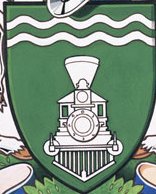 |
| Steer |
Guichon, J.I. Vol VI, P 361 |
 The Steer (a castrated bull) represents the livestock of the western ranching country of Canada. The Steer (a castrated bull) represents the livestock of the western ranching country of Canada. |
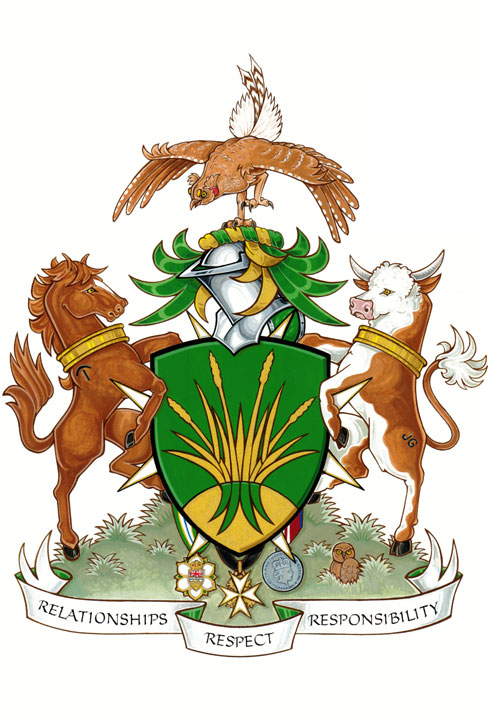 |
| Steller’s Jay |
Holmes, P.D.P. (Badge) Vol Iv, P 306 |
 The Steller's Jay is native to Western North America. It is the official bird of British Columbia. It differs from the Blue Jay in having a black head and upper body. The Steller's Jay is native to Western North America. It is the official bird of British Columbia. It differs from the Blue Jay in having a black head and upper body. |
 |
| Stellar Lights |
Corel Corporation. Vol III, P 118 |
 The Stellar Lights, appearing in the shield between the two flaunches, allude to the night sky through which computer information flows. The Stellar Lights, appearing in the shield between the two flaunches, allude to the night sky through which computer information flows. |
 |
| Stetson Hat |
Calgary Petroleum Club. Vol II, P 134 |
 The Stetson Hat is traditionally seen as a symbol of the ranchers of the West - and, by extension, of the West itself. The Stetson Hat is traditionally seen as a symbol of the ranchers of the West - and, by extension, of the West itself. |
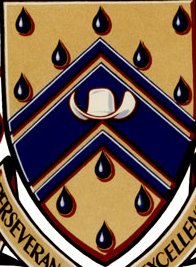 |
| Stove |
Fawcett Family Association (Flag) Vol IV, P 40 |
The Wood-Stove, seen here in the fly, is used on this occasion to refer to the grantee’s company, which manufactures them. It may also allude in more general terms to the warmth of a family or home. |
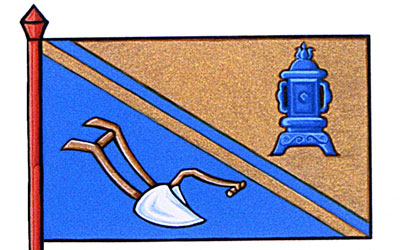 |
| Strawberry Flower |
City of Abbotsford, BC. Vol III, P 59 |
 The Strawberry Flower is the floral emblem of the Fraser clan and is a reference to the Fraser Valley. The Strawberry Flower is the floral emblem of the Fraser clan and is a reference to the Fraser Valley. |
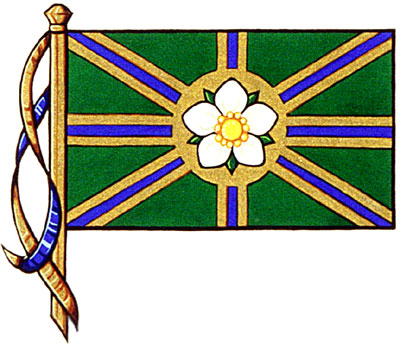 |
| Sugar Cane |
Francis, M.E. Vol V, P 236 |
 The sugar cane in saltire in the arms represents the West Indian origin of the grantee. The sugar cane in saltire in the arms represents the West Indian origin of the grantee. |
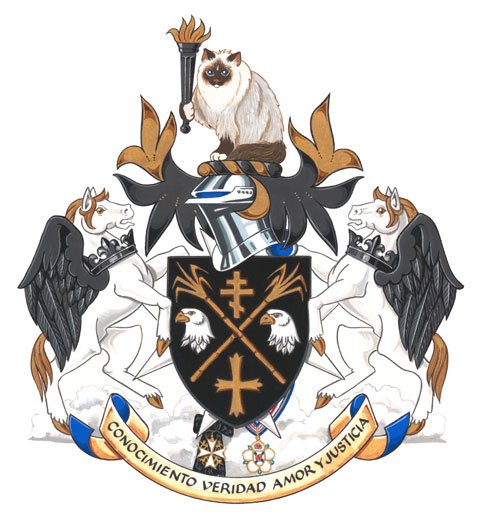 |
| Sugar Loaf |
Zaharescu, Barbara. Vol IV, P 157 |
 The Sugar Loaf, shown in this crest between two wings, was the traditional form in which refined sugar was produced and sold until the late 19th century. The Sugar Loaf, shown in this crest between two wings, was the traditional form in which refined sugar was produced and sold until the late 19th century. |
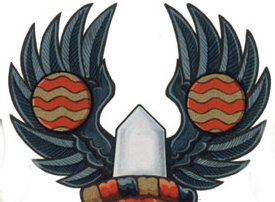 |
| Sumac, Sprig of |
Lady Eaton College, Peter-borough, ON. Vol I, P 14 |
 The sprig of Sumac (shown here in the quarters) is a typical North American plant. Its stems have a soft pith, which can be hollowed out. This made them useful in the making of traditional Native American pipes. The sprig of Sumac (shown here in the quarters) is a typical North American plant. Its stems have a soft pith, which can be hollowed out. This made them useful in the making of traditional Native American pipes. |
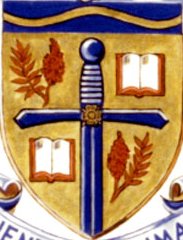 |
| Surveyor's Chain |
Assoc. of Ontario Land Surveyors. Vol II, P 143 |
 The Surveyor's Chain was, until the development of electronic tools, the instrument used by land surveyors to measure distance. One tenth of a furlong, or one-eightieth of a mile long, it had to be both accurate and tough. It symbolizes the surveyor's profession. The Surveyor's Chain was, until the development of electronic tools, the instrument used by land surveyors to measure distance. One tenth of a furlong, or one-eightieth of a mile long, it had to be both accurate and tough. It symbolizes the surveyor's profession. |
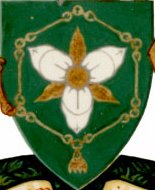 |
| Swainson's Hawk |
Maciborski, S.R. Vol Vi, P 433 |
 Swainson's Hawk is a native inhabitant of the Great Plains. Here it represents strength, vision and protection. Swainson's Hawk is a native inhabitant of the Great Plains. Here it represents strength, vision and protection. |
 |
| Swan-Gazelle |
Quebec City Ballet. Vol V, P 419 |
 This half-swan, half-gazelle hybrid animal represents the grace and power of ballet. This half-swan, half-gazelle hybrid animal represents the grace and power of ballet. |
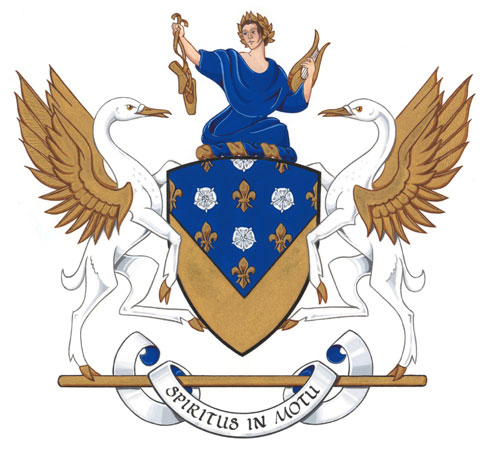 |
| Swan, Trumpeter |
Town of Creston, BC. Vol V, P314 |
 The Trumpeter Swans refer in this case to the original name, "Valley of the Swans", before Creston was incorporated. The Trumpeter Swans refer in this case to the original name, "Valley of the Swans", before Creston was incorporated. |
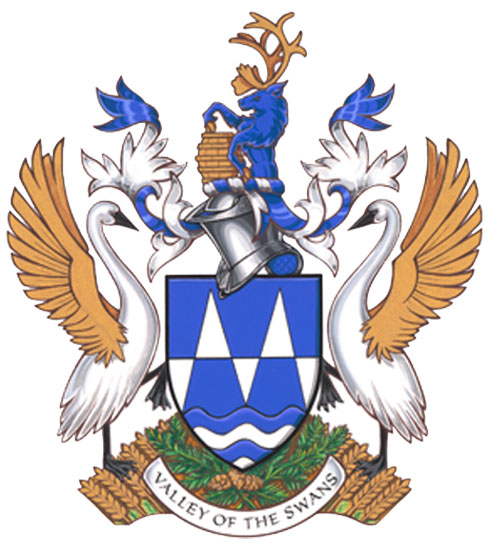 |
| Symbol for Man |
Bogie, J M. Vol IV, P 127 |
 The Symbol for Man – a circle with an arrow projecting at an angle – was originally the symbol for Mars. It was also used as the alchemic symbol for iron and is used here to refer to the grantee’s mining explorations. The Symbol for Man – a circle with an arrow projecting at an angle – was originally the symbol for Mars. It was also used as the alchemic symbol for iron and is used here to refer to the grantee’s mining explorations. |
 |
| Symbol for Women |
Campbell, Avril Kim. Vol II, P 380 |
 The small circle with a cross beneath it is an ancient symbol of the Greek goddess Aphrodite and the Roman goddess Venus. It therefore symbolizes all women and their importance in society. The small circle with a cross beneath it is an ancient symbol of the Greek goddess Aphrodite and the Roman goddess Venus. It therefore symbolizes all women and their importance in society. |
 |
 Canadian Heraldic Dictionary
Canadian Heraldic Dictionary Canadian Heraldic Dictionary
Canadian Heraldic Dictionary

 The Sabre-toothed Tiger is a prehistoric animal related to the modern tiger. It is used here to depict the nickname of the squadron which flew the Sabre jet. It may also be used to suggest ferocity.
The Sabre-toothed Tiger is a prehistoric animal related to the modern tiger. It is used here to depict the nickname of the squadron which flew the Sabre jet. It may also be used to suggest ferocity.
 The 17th-century Sailing Ship alludes to the arrival of Champlain and the original settlers in Quebec in 1608.
The 17th-century Sailing Ship alludes to the arrival of Champlain and the original settlers in Quebec in 1608.
 The salmon is an important local species and is shown here in the artistic style of the Coast Salish nation.
The salmon is an important local species and is shown here in the artistic style of the Coast Salish nation.
 The Salt-bank Schooner is typical of the sailing ships of Canada's East Coast.
The Salt-bank Schooner is typical of the sailing ships of Canada's East Coast.
 The Sand dollar is a marine creature found on both Atlantic and Pacific Coasts of Canada. It is a special talisman of Her Excellency.
The Sand dollar is a marine creature found on both Atlantic and Pacific Coasts of Canada. It is a special talisman of Her Excellency.

 Sapinagé refers to a division line formed of alternating fir twigs.
Sapinagé refers to a division line formed of alternating fir twigs.
 The Saskatoon Bush held in the lion’s paw is a direct reference to the name of the ship.
The Saskatoon Bush held in the lion’s paw is a direct reference to the name of the ship.

 The Scottish Terrier, or Scottie, is a popular companion. It is an independent and rugged breed, originating in Scotland.
The Scottish Terrier, or Scottie, is a popular companion. It is an independent and rugged breed, originating in Scotland.
 The Scuba Diver in these arms is a reference to the grantee’s experience as a diver.
The Scuba Diver in these arms is a reference to the grantee’s experience as a diver. 
 The Sculptor's wooden Mallet, as seen here in both shield and crest is the main implement of the sculptor and symbolic thereof.
The Sculptor's wooden Mallet, as seen here in both shield and crest is the main implement of the sculptor and symbolic thereof.
 The Sea Bison is seen here as the dexter supporter. The bison is the Provincial animal of Manitoba. The lower body of a fish refers to the grantee's skills in limnology - the study of lakes and rivers.
The Sea Bison is seen here as the dexter supporter. The bison is the Provincial animal of Manitoba. The lower body of a fish refers to the grantee's skills in limnology - the study of lakes and rivers.
 The Sea Boar is an heraldic boar with a dolphin's tail. It suggests strength and power associated with the sea or maritime pursuits.
The Sea Boar is an heraldic boar with a dolphin's tail. It suggests strength and power associated with the sea or maritime pursuits.
 The Sea Caribou combines the Body of a caribou with the tail of a fish.
The Sea Caribou combines the Body of a caribou with the tail of a fish.
 In Greek and Roman Mythologies, Cerberus is a three-headed dog guarding the Underworld. This creature has been converted into a sea monster to represent the maritime/naval nature of the Group.
In Greek and Roman Mythologies, Cerberus is a three-headed dog guarding the Underworld. This creature has been converted into a sea monster to represent the maritime/naval nature of the Group. 
 The Sea Cougar, shown as the sinister supporter of the arms, combines the head and upper body of a cougar with the tail, scales and fins of a fish.
The Sea Cougar, shown as the sinister supporter of the arms, combines the head and upper body of a cougar with the tail, scales and fins of a fish.
 The Sea Deer shown as the dexter supporter of the arms, combines the head and upper body of a deer with the tail, scales and fins of a fish.
The Sea Deer shown as the dexter supporter of the arms, combines the head and upper body of a deer with the tail, scales and fins of a fish.
 The Sea Doe (the dexter supporter) is a combination of a female deer and a whale or porpoise, representing swiftness and tireless effort.
The Sea Doe (the dexter supporter) is a combination of a female deer and a whale or porpoise, representing swiftness and tireless effort.
 The Sea Griffin, combining the characteristics of an eagle, a lion and a fish, represents the three elements (air, land and sea) of the Canadian Forces.
The Sea Griffin, combining the characteristics of an eagle, a lion and a fish, represents the three elements (air, land and sea) of the Canadian Forces.
 The Heraldic Sea Lion shows a lion with a fish's tail. It alludes to the lion supporters of the arms of the City of Windsor, Ontario, but with a fish's tail to suggest the sea.
The Heraldic Sea Lion shows a lion with a fish's tail. It alludes to the lion supporters of the arms of the City of Windsor, Ontario, but with a fish's tail to suggest the sea.
 The Sea Otter is a reference to an important element of the 19th-century fur trade in north-western Canada.
The Sea Otter is a reference to an important element of the 19th-century fur trade in north-western Canada.
 The Owl is an ancient symbol of wisdom. The lower, fish-like, part alludes to the grantee's love of water sports.
The Owl is an ancient symbol of wisdom. The lower, fish-like, part alludes to the grantee's love of water sports.
 The Sea Quilin is seen here as the sinister supporter. The Qilin is a hooved animal of Chinese mythology, representing benevolence, good will and good government. The lower body of a fish alludes to the Grantee's skills in limnology - the study of lakes and rivers.
The Sea Quilin is seen here as the sinister supporter. The Qilin is a hooved animal of Chinese mythology, representing benevolence, good will and good government. The lower body of a fish alludes to the Grantee's skills in limnology - the study of lakes and rivers.

 The Sea Stag (shown here on the dexter side of the shield) is a stag with a fish's tail.
The Sea Stag (shown here on the dexter side of the shield) is a stag with a fish's tail.
 The Tiger alludes to the sinister supporter of the City of Hamilton's arms, while the fish's tail refers to the aquatic activities of the yacht club.
The Tiger alludes to the sinister supporter of the City of Hamilton's arms, while the fish's tail refers to the aquatic activities of the yacht club.

 The natural Sea Horse - as distinct from its well-known heraldic form - is a bony, scale-less fish that swims upright. It evokes the aquatic world.
The natural Sea Horse - as distinct from its well-known heraldic form - is a bony, scale-less fish that swims upright. It evokes the aquatic world.
 The Secretary Bird is a predatory bird of Africa, used heraldically because of its name to refer to secretaries, journalists and authors.
The Secretary Bird is a predatory bird of Africa, used heraldically because of its name to refer to secretaries, journalists and authors.
 The dexter supporter in these arms (shown as a woman with a whale's tail) represents Sedna, a famous creature from mythology around the circum-polar world and known as the Sea Ruler of the Arctic.
The dexter supporter in these arms (shown as a woman with a whale's tail) represents Sedna, a famous creature from mythology around the circum-polar world and known as the Sea Ruler of the Arctic.

 The Semaphore Tower was a method of communicating messages over a visible distance, prior to the invention of the electric telegraph.
The Semaphore Tower was a method of communicating messages over a visible distance, prior to the invention of the electric telegraph.
 The curved partition line in bend sinister is blazoned as Serpentine.
The curved partition line in bend sinister is blazoned as Serpentine.
 The Sharp-shinned Hawk is a small hawk of the US and Canada, occurring primarily in woodland country.
The Sharp-shinned Hawk is a small hawk of the US and Canada, occurring primarily in woodland country.
 The Shearwater is pelagic bird of temperate and cool waters. These birds fly with stiff wings, using a shearing flight technique to skim across wave fronts with a minimum of active flight.
The Shearwater is pelagic bird of temperate and cool waters. These birds fly with stiff wings, using a shearing flight technique to skim across wave fronts with a minimum of active flight.
 The shield shown here is typical of those used in Kenya, and refers to the grantee's place of birth.
The shield shown here is typical of those used in Kenya, and refers to the grantee's place of birth.
 The Ship's Propeller, shown here in the base, alludes to the grantee's association with manufacturing for the fishing industry.
The Ship's Propeller, shown here in the base, alludes to the grantee's association with manufacturing for the fishing industry. 
 The Shofar (shown here in base) is an ancient Jewish musical instrument, most often made from a ram’s horn. It is used in Bishop Dowd’s arms to symbolize the action of announcing the glory of God and the coming day of the Lord.
The Shofar (shown here in base) is an ancient Jewish musical instrument, most often made from a ram’s horn. It is used in Bishop Dowd’s arms to symbolize the action of announcing the glory of God and the coming day of the Lord.
 The Silo (in its agricultural sense) is a cylindrical tower, often attached to a barn and used to store grain. It refers here to the family’s agricultural heritage.
The Silo (in its agricultural sense) is a cylindrical tower, often attached to a barn and used to store grain. It refers here to the family’s agricultural heritage.
 Simbi (shown here as supporters) are water spirits from the Haitian culture, who comfort souls, purify troubled waters and intervene with wisdom and foresight. They allude to Her Excellency's Haitian background and the vital role of women in advancing social justice.
Simbi (shown here as supporters) are water spirits from the Haitian culture, who comfort souls, purify troubled waters and intervene with wisdom and foresight. They allude to Her Excellency's Haitian background and the vital role of women in advancing social justice.
 The Skis shown in the crest refer to the City of Rossland as a training centre for world-class skiers.
The Skis shown in the crest refer to the City of Rossland as a training centre for world-class skiers.
 The Small-mouth Bass shown held by the eagle in the crest symbolizes sport fishing in the local rivers.
The Small-mouth Bass shown held by the eagle in the crest symbolizes sport fishing in the local rivers.
 The Snow Goose is a North American species of goose, its name deriving from the typically white plumage. It nests and mates in arctic regions, but winters in warm parts of the continent, from western BC through parts of the US to Mexico. In these arms, it alludes to the wide range of communications performed by the Squadron.
The Snow Goose is a North American species of goose, its name deriving from the typically white plumage. It nests and mates in arctic regions, but winters in warm parts of the continent, from western BC through parts of the US to Mexico. In these arms, it alludes to the wide range of communications performed by the Squadron.
 The Snow Knife (held by each of the supporters) is a tool used in the construction of igloos.
The Snow Knife (held by each of the supporters) is a tool used in the construction of igloos.
 The Snow Leopard is a large cat native to the mountain ranges of South Asia. It is the National Heritage Animal of Pakistan. It can recognize Pakistani origin or, as in this case, strength of character.
The Snow Leopard is a large cat native to the mountain ranges of South Asia. It is the National Heritage Animal of Pakistan. It can recognize Pakistani origin or, as in this case, strength of character.

 The Snowy Owl is a large owl native to the arctic regions of North America and Eurasia. Many males are in fact, white, but females tend to be white with significant brown or black speckling. Unlike most other owls, the Snowy is not nocturnal, since during their breeding and nesting periods in the Arctic summer, there is almost constant daylight.
The Snowy Owl is a large owl native to the arctic regions of North America and Eurasia. Many males are in fact, white, but females tend to be white with significant brown or black speckling. Unlike most other owls, the Snowy is not nocturnal, since during their breeding and nesting periods in the Arctic summer, there is almost constant daylight.
 The Snowshoe, as seen in the sinister chief, is the classic North American form of winter-travel footwear.
The Snowshoe, as seen in the sinister chief, is the classic North American form of winter-travel footwear.

 The Song Thrush is a European bird used here to suggest its beautiful song and the grantee's British origin.
The Song Thrush is a European bird used here to suggest its beautiful song and the grantee's British origin.
 Songbirds are a class of small birds noted for well-developed musical calls. They are used in this instance to refer to the musical elements of the Society’s productions.
Songbirds are a class of small birds noted for well-developed musical calls. They are used in this instance to refer to the musical elements of the Society’s productions. 
 The Sparrowhawk is a brave warrior with keen eyesight.
The Sparrowhawk is a brave warrior with keen eyesight.


 The blazon for this crest is - "Issuant from flames, a Coast Salish spindle whorl charged with a raven, all Argent, embellished Azure."
The blazon for this crest is - "Issuant from flames, a Coast Salish spindle whorl charged with a raven, all Argent, embellished Azure."
 The Spirit of Kwantlen is a device of the Kwantlen First Nation, showing a wolf, a salmon and a river (the central swirl). It is used here as a symbol of the College.
The Spirit of Kwantlen is a device of the Kwantlen First Nation, showing a wolf, a salmon and a river (the central swirl). It is used here as a symbol of the College.

 The Spud Wrench (held here by the caribou) is a tool used by riggers in the construction of steel buildings.
The Spud Wrench (held here by the caribou) is a tool used by riggers in the construction of steel buildings.
 St. Bartholomew, one of the Twelve Apostles, is traditionally pictured as holding a large knife in his hand, referring to the belief that he was martyred by being skinned alive. The knife pictured in these arms is similar to that held by a famous statue of the saint in the Basilica of St. John Lateran in Rome.
St. Bartholomew, one of the Twelve Apostles, is traditionally pictured as holding a large knife in his hand, referring to the belief that he was martyred by being skinned alive. The knife pictured in these arms is similar to that held by a famous statue of the saint in the Basilica of St. John Lateran in Rome.
 The St. Bernard is well-known for loyalty, fidelity and obedience. The piano alludes to the grantee's love of music.
The St. Bernard is well-known for loyalty, fidelity and obedience. The piano alludes to the grantee's love of music. 
 The Stage with footlights,– seen here as the compartment – alludes to the theatrical performances organized by the Society.
The Stage with footlights,– seen here as the compartment – alludes to the theatrical performances organized by the Society.


 The Star of Life (shown in Azure) represents emergency medical services.
The Star of Life (shown in Azure) represents emergency medical services.
 This delightful star (or sun) of sixteen separate points surrounding a central circle closely resembles a compass rose. Its name refers to the town of Vergina in northern Greece, where it was found during archeological ex-cavations. It is associated with Philip of Macedon, father of Alexander the Great. The fleur de lis is an added charge.
This delightful star (or sun) of sixteen separate points surrounding a central circle closely resembles a compass rose. Its name refers to the town of Vergina in northern Greece, where it was found during archeological ex-cavations. It is associated with Philip of Macedon, father of Alexander the Great. The fleur de lis is an added charge.
 The Life Preserver is a direct reference to the ship's name. The Starburst at its centre represents the flare that is automatically ignited when the flare touches the water.
The Life Preserver is a direct reference to the ship's name. The Starburst at its centre represents the flare that is automatically ignited when the flare touches the water.
 The Locomotive is seen here in frontal view. It symbolizes the importance of the railroad in the development of Western Canada.
The Locomotive is seen here in frontal view. It symbolizes the importance of the railroad in the development of Western Canada.
 The Steer (a castrated bull) represents the livestock of the western ranching country of Canada.
The Steer (a castrated bull) represents the livestock of the western ranching country of Canada.
 The Steller's Jay is native to Western North America. It is the official bird of British Columbia. It differs from the Blue Jay in having a black head and upper body.
The Steller's Jay is native to Western North America. It is the official bird of British Columbia. It differs from the Blue Jay in having a black head and upper body.
 The Stellar Lights, appearing in the shield between the two flaunches, allude to the night sky through which computer information flows.
The Stellar Lights, appearing in the shield between the two flaunches, allude to the night sky through which computer information flows.
 The Stetson Hat is traditionally seen as a symbol of the ranchers of the West - and, by extension, of the West itself.
The Stetson Hat is traditionally seen as a symbol of the ranchers of the West - and, by extension, of the West itself.

 The Strawberry Flower is the floral emblem of the Fraser clan and is a reference to the Fraser Valley.
The Strawberry Flower is the floral emblem of the Fraser clan and is a reference to the Fraser Valley.
 The sugar cane in saltire in the arms represents the West Indian origin of the grantee.
The sugar cane in saltire in the arms represents the West Indian origin of the grantee.
 The Sugar Loaf, shown in this crest between two wings, was the traditional form in which refined sugar was produced and sold until the late 19th century.
The Sugar Loaf, shown in this crest between two wings, was the traditional form in which refined sugar was produced and sold until the late 19th century.
 The sprig of Sumac (shown here in the quarters) is a typical North American plant. Its stems have a soft pith, which can be hollowed out. This made them useful in the making of traditional Native American pipes.
The sprig of Sumac (shown here in the quarters) is a typical North American plant. Its stems have a soft pith, which can be hollowed out. This made them useful in the making of traditional Native American pipes.
 The Surveyor's Chain was, until the development of electronic tools, the instrument used by land surveyors to measure distance. One tenth of a furlong, or one-eightieth of a mile long, it had to be both accurate and tough. It symbolizes the surveyor's profession.
The Surveyor's Chain was, until the development of electronic tools, the instrument used by land surveyors to measure distance. One tenth of a furlong, or one-eightieth of a mile long, it had to be both accurate and tough. It symbolizes the surveyor's profession.
 Swainson's Hawk is a native inhabitant of the Great Plains. Here it represents strength, vision and protection.
Swainson's Hawk is a native inhabitant of the Great Plains. Here it represents strength, vision and protection.
 This half-swan, half-gazelle hybrid animal represents the grace and power of ballet.
This half-swan, half-gazelle hybrid animal represents the grace and power of ballet.
 The Trumpeter Swans refer in this case to the original name, "Valley of the Swans", before Creston was incorporated.
The Trumpeter Swans refer in this case to the original name, "Valley of the Swans", before Creston was incorporated. 
 The Symbol for Man – a circle with an arrow projecting at an angle – was originally the symbol for Mars. It was also used as the alchemic symbol for iron and is used here to refer to the grantee’s mining explorations.
The Symbol for Man – a circle with an arrow projecting at an angle – was originally the symbol for Mars. It was also used as the alchemic symbol for iron and is used here to refer to the grantee’s mining explorations.
 The small circle with a cross beneath it is an ancient symbol of the Greek goddess Aphrodite and the Roman goddess Venus. It therefore symbolizes all women and their importance in society.
The small circle with a cross beneath it is an ancient symbol of the Greek goddess Aphrodite and the Roman goddess Venus. It therefore symbolizes all women and their importance in society.